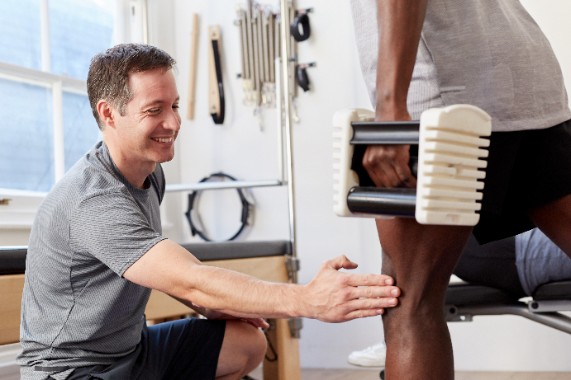FAIs Case study
Triad of symptoms (Warrick agrreemenet)
- Symptoms / Hip and Groin Pain
- Imaging / +ive (Morphology) Soft tissue / labral
- Signs – Impingement tests – see below
- Physical impairments – poor performance functional tests. Reduced ROM Reduced MP
Clinical Presentation
- Female runner
- 34 year old
- Gradual Onset of groin pain over 2 years
- Anterior thigh / into buttock
- High irritability
- Gradually getting worse
- ℅ Clicking
- Low back Pain
Aggravating activities
- Painful on change of direction, stairs.
- Limping
- Unable to sit for >20 mins
- Flexion based activities
- In and out of a seat / chair or car
- Yoga poses
Easing
- NSAIDs and paracetamol (not helping much)
- Rest (reluctant)
Medical History
- Nil to note
- FH – Nil
- PMH – Nil
Physiotherapy and Medical Management
?Onward Referral for diagnosis if required
- MRI of the hip
- Analgesia
- Rest and offload (activity management) based on functional capacity.
- Address muscular low back pain
- Expectations management and goal setting
- Address Muscular imbalances – long Iliopsoas muscle – likely weak (resisted hip flexion)
- Pain on Thomas test –
- Pain management – STM, TPr
- Postural education – not to hyperextend hips (women)
- Trunk (abdominal and gluteal) strengthening/Endurance
- Education – avoiding prolonged sitting, cycling, rowing, excessive hip adduction and flexion.
- Load Management
- Rehabilitation – balance / proprioception, sporting technique and movement quality
Rehabilitation
- Phased return package
- Sensitive / irritable don’t poke the bear. Avoid positions that are irritable for the time being.
- Squat difficulty
i Get them squatting in a pain free way.
ii Hip ABd / ER / Use a gym ball.
iii Add load via Trap bar. Minimal pain squatting.
- Specific exercise plan based on function. Recreate positions based on function.
- Maintain comprehensive strength through a gym based programme. Quads, Hams, Lx spine. Stay strong. Offload from painful positions.
- Pseudo giving way – body’s protective mechanism – perhaps not tolerable through range. Slowly move to an uncomfortable position as it starts to feel better. Use pain tolerance as a guide. If you can stay strong through movement – good sign.
- Depth
- Sets and Reps
- Speed is a component of a force. Move quickly at a higher velocity creates higher force. Mass x Acceleration.
- Timeline – back to sport within 6 weeks of initial clinic.
Exercises
- 4 Point Kneeling – Hip Extension
– Watch points good pelvic alignment, neutral lumbar spine, scapulae stability. +/_ resistance bands through Hip Extension
- Glute bridge – Turn out foot position, mindful not to push through into hip extension, Use of theraband into abduction +/- step +/- Single Leg
- Single leg control, Single leg with KB +/- TRX, +/- Bosu
- Double leg squat, Hip abduction, Foot in turnout, +/- theraband into abduction +/- weighted squat i.e Goblet +/- Bosu
- Bulgarian Split squat for eccentric Psoas, stretch and front leg glute / hip control +/- weighted squat i.e Goblet +/- Bosu
Watch out for Red Flags
- Adolescent (perthes, slipped capital femoral epiphysis) Low Threshold for referral / additional imaging.
- Middle Aged 40 – 60 (possible underlying) OA
- >6/12 history of chronic groin pain (likely hip pain source)
- Female runners – stress fracture femoral neck (Compression, Displaced, Tension)
- Previous history of Ca
- Night pain
- Trauma – post traumatic OA
- Perthes/Childhood hip disease – increased likelihood to develop OA
- Family history
- Early OA/ THR
Screening test
FlexionAdd and IR (Impingement test) Not be negative
FABER
Both good at ruling out
Hip related Groin Pain (Non Red Flag)
- FAIS
- Labrum
- Chondral (AM stiffness)
OA
- Early AM stiffness for a few mins (CAM, OA)
More than 10mins consider RA, AS, Inflammatory conditions – better with NSAIDs
- Groin Pain, Anterior Thigh, lateral hip, buttock pain, lumbar spine pain.
- Ache, decreased ROM through IR<15degrees – effects SIJ and Lumbar spine mechanics.
FAI
- AGG – Sitting
- Hip Flexion – long periods 20-30mins
- No response to NSAIDs
- High Irritability
- Increased flare ups (labral pathologies)
- Intensity of groin pain (high)
- Spectrum of FAI – Labral, Bone marrow oedema, chondral oedema.
Acute Labral
- Clicking, catching
- High level of pain
- Sharp as well as an underlying dullness
- Night pain
- Easy to flare up – long rehab
- Early OA 30-55
- hip impingement
- labrum
- hip dysplasia
- EOR pain Abd/ IR
- Post natal – hormonal changes, loss of dynamic stability
- Simple XR to diagnose between OA and dysplasia
Morphology
- Pincer – Extra bone on the Acetabulum is deeper, over coverage
- Cam – Convex shape of Head Neck Jnct 60% / Extra bone on the femur / common in athletic loading / youth / Femoral growth plate is open. Twisting turning, Axial loading (Football / American f’ball)
- Combined – Mixed deeper acetabulum / +extra bone on the Femur
- Clicking, locking, catching, giving way and pain on twisting may suggest a presence of labral or chondral pathology.
